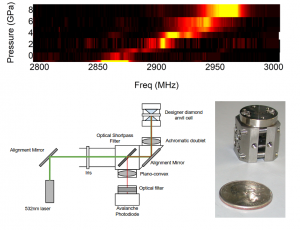Optically Detected Magnetic Resonance at High Pressure

Optically detected magnetic resonance (ODMR) of NV centers offers a novel approach to magnetometry in a diamond anvil cell. Matthew Lawson’s and Lou Steele’s work was recently published in Applied Physics Letters, where they demonstrated that ODMR can be achieved up to 8 GPa using microdiamonds and a novel designer anvil. In this case, there are two separate types of diamonds employed: diamond anvils, and microdiamonds. The diamond anvils are large gemstones arranged so that the tips of two anvils are pressed together to create high pressures. A small hole in a metallic gasket sits between the two anvils in order to contain a sample of interest. The hole is typically very small, around the diameter of a human hair. The microdiamonds are located within this hole, and they are specially prepared with a high concentration of NV centers. The NV centers are essentially isolated `molecules’ embedded in the diamond matrix, and as the pressure increases their electronic properties change.
